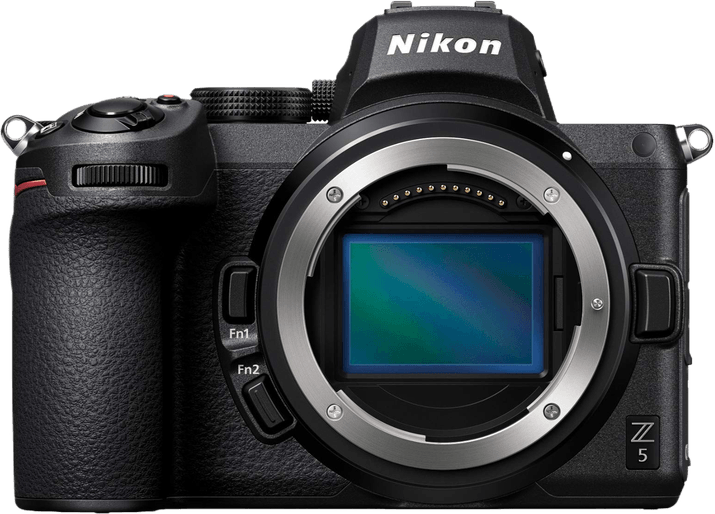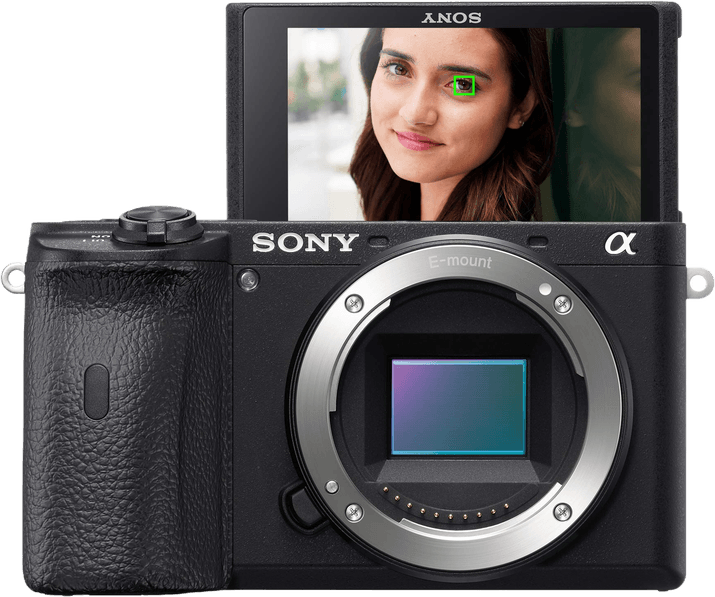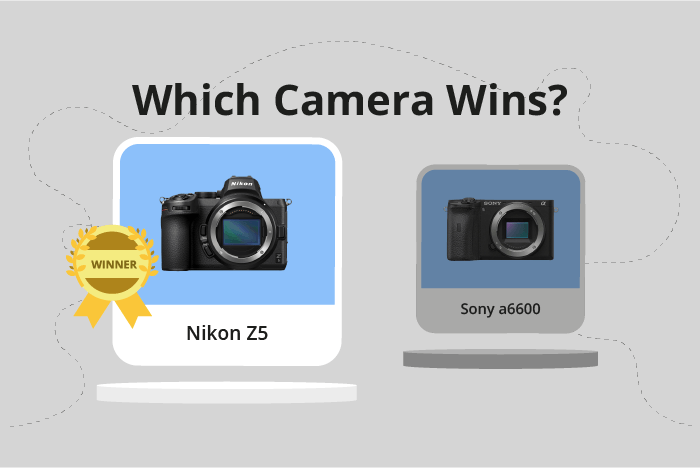Nikon Z5 vs Sony a6600 Comparison
Nikon Z5

Sony a6600

The Nikon Z5 emerges as the winner with a score of 78/100, while the Sony a6600 trails closely behind at 75/100. Both cameras are mirrorless and were released in 2019 and 2020, respectively. The Nikon Z5 is slightly more expensive, with a launch price of $1400 compared to the Sony a6600’s $1200.
The Nikon Z5 has a larger body, measuring 134 x 100.5 x 69.5mm and weighing 675g, which may offer a more comfortable grip. On the other hand, the Sony a6600 is more compact and lightweight at 120 x 67 x 69mm and 503g, making it easier to carry around during long shoots.
Taking into account the scores and specifications, the Nikon Z5 offers a better overall experience, while the Sony a6600 provides a more portable option for photographers on the go.
Nikon Z5 vs Sony a6600 Overview and Optics
The Nikon Z5 takes the lead in optics with a score of 81/100, while the Sony a6600 trails behind with a score of 76/100. Both cameras share similarities such as having 24 and 24.2 megapixels, CMOS sensor type, and image stabilization. These common features display the competitive nature of these cameras.
The Nikon Z5 outperforms the Sony a6600 in certain aspects. With its Expeed 6 processor, the Z5 ensures fast and efficient image processing. Moreover, the Z5 has a higher DXOMARK score for the sensor at 97, compared to the a6600’s score of 82. This difference illustrates the Z5’s superior image quality. Additionally, the Z5’s full-frame sensor size and Nikon Z lens mount provide a wider range of lens options and better low-light performance.
On the other hand, the Sony a6600 excels in shooting speed, boasting an impressive 11 frames per second compared to the Z5’s 4.5. This advantage makes the a6600 an ideal choice for capturing fast-moving subjects and action photography. The a6600 also features the Bionz X processor, which is known for its reliable performance.
To conclude, the Nikon Z5’s superior optics are evident in its higher score, full-frame sensor, and better image quality. However, the Sony a6600’s faster shooting speed may appeal to action photographers. Ultimately, the choice between these cameras depends on individual preferences and specific photography needs.
Nikon Z5 vs Sony a6600 Video Performance
The Sony a6600 outperforms the Nikon Z5 in video capabilities, scoring 91/100 compared to the Nikon Z5’s 83/100. Both cameras share several common video specifications, including a maximum video resolution of 4K and video dimensions of 3840 x 2160. Additionally, both cameras have built-in time-lapse functionality.
The Sony a6600 surpasses the Nikon Z5 with its higher maximum video frame rate of 100fps, compared to the Z5’s 60fps. This higher frame rate allows the a6600 to capture smoother and more detailed slow-motion footage, providing a significant advantage to videographers.
While the Nikon Z5 falls short in maximum video frame rate, it still offers respectable video capabilities with its 60fps performance. This frame rate is suitable for most casual videographers and content creators, although professionals may prefer the higher frame rate offered by the Sony a6600.
Taking these factors into account, it is clear that the Sony a6600 is the superior camera for video capabilities due to its higher video score and maximum frame rate. However, the Nikon Z5 remains a viable option for those looking for solid video performance with a slightly lower frame rate. Both cameras excel in video resolution and built-in time-lapse functionality, making them suitable choices for a variety of video projects.
Nikon Z5 vs Sony a6600 Features and Benefits
The Sony a6600 emerges as the winner in the features comparison, scoring 81/100, while the Nikon Z5 scores 72/100. Both cameras share several common specifications, including a touchscreen, flip screen, WIFI, and Bluetooth capabilities. However, neither camera offers GPS functionality.
The Sony a6600 has a slight advantage in terms of screen size, with a 3-inch display compared to the 3.2-inch display on the Nikon Z5. However, the Nikon Z5 outperforms the Sony a6600 in screen resolution, boasting 1,040,000 dots compared to the a6600’s 921,600 dots. This difference in resolution means that the Nikon Z5 provides a clearer, more detailed image on its larger screen.
Despite this advantage in screen resolution, the Sony a6600 still scores higher due to its overall better performance and additional features. The Sony a6600 offers a more compact and lightweight body, making it easier to carry and handle during shooting sessions. Additionally, the a6600 has a longer battery life, allowing for more extended periods of use without the need for frequent battery changes or charging.
On the other hand, the Nikon Z5 has a higher resolution sensor, providing more detailed and sharper images. This advantage can be beneficial for photographers who prioritize image quality over other features.
Taking these factors into consideration, the Sony a6600 is the better choice for users who value portability, battery life, and a more extensive feature set. In contrast, the Nikon Z5 is more suitable for those who prioritize image quality and a larger, higher-resolution screen.
Nikon Z5 vs Sony a6600 Storage and Battery
The Nikon Z5 outperforms the Sony a6600 in storage and battery with a score of 73/100 compared to the latter’s 48/100. Both cameras share common features, such as USB charging and compatibility with SD/SDHC/SDXC memory cards. However, the Z5 has an advantage with its dual memory card slots, accepting UHS-II compatible cards, while the a6600 has only one slot and also accepts Memory Stick Pro Duo cards.
The Z5’s higher score is primarily due to its two memory card slots, providing more storage options and backup capabilities. In contrast, the Sony a6600 excels in battery life, offering 810 shots per charge compared to the Z5’s 470 shots. This distinction makes the a6600 more suitable for extended shooting sessions without needing to change batteries.
Taking both storage and battery factors into account, the Nikon Z5 proves to be a more versatile and reliable camera for photographers needing ample storage and backup options. Meanwhile, the Sony a6600 is better suited for those prioritizing longer battery life for uninterrupted shooting.
Nikon Z5 vs Sony a6600 – Our Verdict
Are you still undecided about which camera is right for you? Have a look at these popular comparisons that feature the Nikon Z5 or the Sony a6600:

